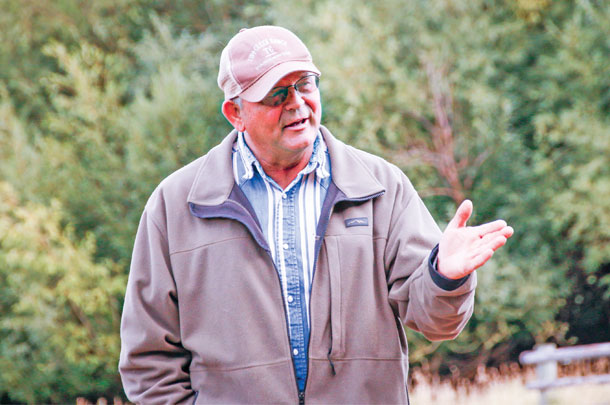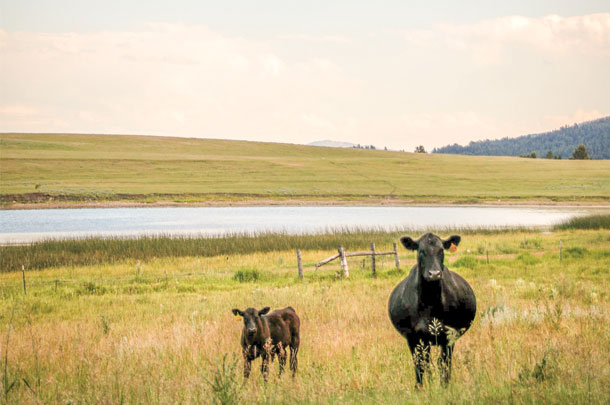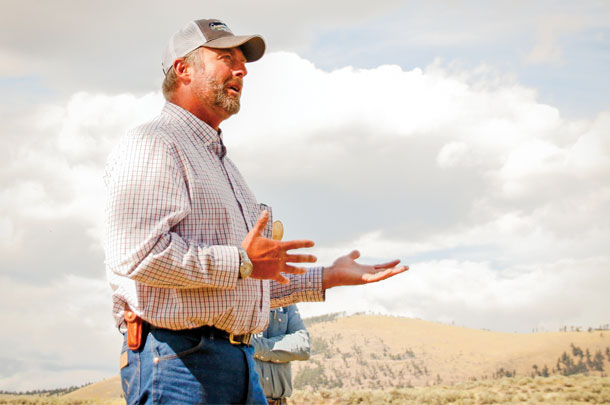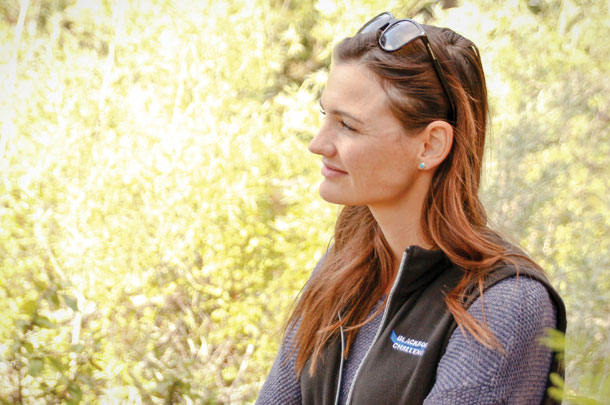But for some who have survived the red tape of the Endangered Species Act, the EPA, state or federal land managers and more, they’ve learned it has to be less about regulations and rules and more about relationships.
“It’s 90 percent people and 10 percent whatever animal or whatever thing we’re dealing with,” Wayne Slaght, a rancher near Ovando, Montana, says.
 Slaght manages the Two Creek Monture Ranch, a 900-head, 21,000-acre deeded and leased commercial cattle ranch in western Montana. They’re surrounded by national parks, protected wilderness areas and recreational landscapes.
Slaght manages the Two Creek Monture Ranch, a 900-head, 21,000-acre deeded and leased commercial cattle ranch in western Montana. They’re surrounded by national parks, protected wilderness areas and recreational landscapes.
They lease state and federal land for grazing while managing riparian areas, wetlands, timber stands and native prairies populated with grizzly bears, wolves, bull trout, trumpeter swans, elk, Sandhill cranes and more.

To say the least, he’s dealt with some red tape in his ranching career. He’s found relationships are the answer.
“You’re sure not going to be able to go out there and tell that grizzly bear what to do,” Slaght says. “You’ve got to work with these people.”
He’s been working with Greg Neudecker, with the Partners for Fish and Wildlife Program of the U.S. Fish and Wildlife Service, for the past 25-plus years to find collaborative solutions to wildlife challenges.
“Is it any wonder we have the problems we have?” Neudecker asks. Ranchers, he says, would typically prefer to work with animals over people and choose solitude over a trip to town. Wildlife biologists are no different.
“So right now, we have two sides who maybe do not have the best people skills. But we have to work together so that we can have sustainable ranching and sustainable wildlife,” Neudecker says. “We need to bring up new leaders on both sides who are willing to have an open mind.”
Here are five tips to use when working on relationships that will help ranchers navigate the red tape and build relationships.
1. Get organized: Ranchers have to step forward
Landowners have to take the first step in bringing diverse interests to the table.
Throughout the Blackfoot Valley, ranchers have taken a leading role in the Blackfoot Challenge. It’s a cooperative conservation effort formed to bring federal, state and local agencies together with landowners, community members and conservation interests.
They all live and work in the 1.5 million-acre watershed and have agreed to work collaboratively for common stewardship goals.
“When this started, it was building a framework that hadn’t been done before,” Neudecker says. Ranchers had to lead the discussion.
Jim Stone owns and manages the Rolling Stone Ranch in the valley and serves as the Blackfoot Challenge chairman. He says, “We had to take our hats off and set the egos aside.”
2. Get involved (outside your typical circle)
A resounding message from ranchers is simple: We trust our friends and neighbors, not government agents. Those feelings go both ways, and the different personas don’t need to be mutually exclusive.
 Kevin Ertl has worked for the U.S. Fish and Wildlife Service in the Blackfoot Valley for more than 17 years.
Kevin Ertl has worked for the U.S. Fish and Wildlife Service in the Blackfoot Valley for more than 17 years.
“I’ve learned more working with landowners and communities here than I ever have behind a desk or in school,” Ertl says. “I love the Fish and Wildlife Service, but I love this community more. That matters.”
Rancher David Mannix agrees, “Kevin’s on the fire department with us; he’s flipping burgers next to me at our community fundraisers. So when it comes time to do Fish and Wildlife business, I’ll listen to him because of that.”
That means ranchers have to be willing to look beyond an agency badge to welcome newcomers to the community and make room for them to get involved.
3. Start small and follow the 80-20 rule
While the Blackfoot Challenge team knew they would have to talk about endangered species and predators, it wasn’t a topic to establish a new, cooperative mindset for either party. Instead, they focused on noxious weed control across their connected public and private lands.
 Sara Schmidt is the education coordinator for the Blackfoot Challenge. “If we were going to build relationships, we had to start with something we could all agree on. We couldn’t jump in with the most controversial topic,” Schmidt says.
Sara Schmidt is the education coordinator for the Blackfoot Challenge. “If we were going to build relationships, we had to start with something we could all agree on. We couldn’t jump in with the most controversial topic,” Schmidt says.
Rancher Land Lindbergh was the first chairman of the Blackfoot Challenge. He says playing by the 80-20 ideal is their rule of thumb. “We had to emphasize the 80 percent of things we could agree on and put aside the 20 percent we couldn’t,” Lindbergh says.
“One of the guiding principles we all agreed on was that we wanted this left as open space. So how were we going to accomplish that together?”
Mannix added that finding that 80 percent in common is easier than some may expect, and says, “We all need open space, healthy soils, water quality and quantity, healthy riparian areas, healthy activity communities, etc.” Those commonalities begin to build the trust needed to tackle the tough 20 percent.
4. Make it personal
As agencies, Neudecker says, “We need to take more time talking about focal people rather than focal species.” He suggests agencies reach out and get more ranching voices on committees, boards and advisory councils. Conversely, ranchers need to step up and volunteer for those positions.
From the ranchers’ perspective, that also means getting to know more people in an agency or organization. When you have a chance to sit down at a table together, both parties must be willing to set stereotypes aside.
“It may seem like a small thing, but take your sunglasses off when you meet someone. That goes a long way to establishing trust,” Schmidt says. “Shake their hand; look them in the eye.”
They’ve asked the agency types to consider leaving their uniforms at home for initial meetings. Likewise, ranchers might be best served to check their hats at the door.
“We stereotype people – it’s unavoidable,” rancher Jim Stone says. “So the more we can do to minimize those – especially on our first meeting – the better. We have to learn to laugh together and work together, person to person, not agency to rancher.”
Schmidt suggests planning one or two casual initial meetings so people can warm up to one another before jumping in to tough topics.
“Don’t start with an agenda. It’s OK to go into a meeting without an agenda or plan; just go in with questions and a willingness to listen,” Schmidt says.
5. It may not help immediately, but it sure doesn’t hurt
“There’s numerous projects that we’ve done with Greg that have not gained us a nickel,” Slaght says. “It’s helped some wildlife, and as long as it’s not going to hurt grazing or take down the production of our ranch, I say, ‘go ahead.’”
One example was the collaborative effort to rejuvenate federally threatened bull trout spawning beds on a ranch creek. They slightly altered some grazing rotations on riparian areas but otherwise simply allowed the wildlife biologists access to conduct their work.
Over the course of the past 30 years, bull trout redd (spawning site) surveys went from detecting only eight redds on Monture Creek in 1989 to averaging more than 50 redds annually, with a high of 92 redds one year.
Stone points to additional examples of voluntary conservation work to restore the bull trout, Blackfoot River and its tributaries. He says, “If we did more work like this across the country, we wouldn’t be listing new species left and right like we are.”
Down the line, those relationships brought about more win-win opportunities. McCabe Creek is a significant stream for fisheries, but it’s also Slaght’s water source for four irrigation diversions. Those diversions pulled nearly all 11 cubic feet per second water capacity from the stream.
Slaght suggested a piping system that would consolidate the diversions into one, adding a fish screen to divert and protect the fisheries, and converting three flood-irrigation fields to sprinkler irrigation. The project was collaboratively funded with cooperating agencies and the ranch.
Today, the ranch uses 2 cubic feet per second for the same area, has increased hay production, decreased labor and improved the fisheries.
“It’s a pretty good success story about what can happen with cooperative agreements when we’re all able to sit down and get on common ground on things we can fix or improve together,” Slaght says. Thanks to their already established trust, “it was a win-win all around.”
Slaght recognizes ranchers may have reason to distrust the folks who regulate and restrict their livelihoods. They haven’t been without struggle and strife of their own.
But at the end of the day, he suggests that to be in business for the generations to come, it’s going to be critical to find what unites ranchers and regulators more often than fighting about what divides them.
“We have to have a common love of the land. We both love what we’re doing,” Slaght says. “That’s the bottom line that we can always agree on.” ![]()
PHOTO 1: Ben Slaght (left), Wayne Slaght (middle) and Ken Kovatch (right) move calves to a new pasture in early morning on the Two Creek Monture Ranch near Ovando, Montana.
PHOTO 2: You’re sure not going to be able to go out there and tell that grizzly bear what to do. You’ve got to work with these people." —Wayne Slaght, manager of Two Creek Monture Ranch
PHOTO 3: The Two Creek Monture Ranch home base is on deeded ground near Ovando, Montana, but has expanded through leases of a game reserve, a ranch lease – the Bandy Ranch, owned by the University of Montana – and a Lolo National Forest grazing permit.
PHOTO 4: "I've learned more working with landowners and communities here than I ever have behind a desk or in school." —Kevin Erlt, U.S. Fish and Wildlife Service
PHOTO 5: "If we were going to build relationships, we had to start with something we could all agree on. We couldn’t jump in with the most controversial topic." —Sara Schmidt, education coordinator for the Blackfoot Challenge. Photos by Laura Nelson.
Laura Nelson is a freelance writer from Big Timber, Montana






